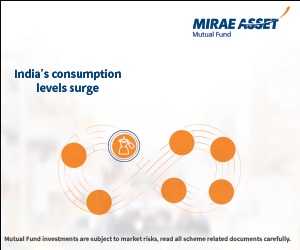Can Large Cap Mutual Funds be your best Investment Option

Investors are always plagued by various investing options in Mutual Funds. Everyone seems to have an opinion about these and they all make it sounds either extremely lucrative or the most risky investment options. In a scenario where the noise of opinions drown even vague ideas you had about investment options, you are more often left feeling utterly confused. In the last article we explore why Balanced funds make good investments. In this article we are going to take a comprehensive look at Large Cap Mutual Funds as an investment option.
What are Large Cap Funds
Large Cap Funds are those mutual funds, which focus on investing primarily in large blue chip companies. Each of the fund houses have their own definition of deciding which stock falls in which category based on market capitalisation. But generally companies with a market capitalisation of Rs 1000 - 1500 crores and above are known as large cap companies. The major advantages of large cap funds is that they are less volatile than Mid and Small Cap funds and the near future of large cap funds can be more accurately predicted as they reflect the state of the economy.
Moreover, the construction of the BSE Sensex and NSE itself are based on market capitalisation of top 30 and top 50 companies of India respectively.
On the other hand, due to the relatively stable nature of these funds, the Large Cap funds have largely offered lower returns than mid cap or small cap funds. However, when compared in totality, large cap funds outperform all other funds by providing stability for risk aversive investors looking for stable and generous returns. In volatile times it is advisable to invest in large cap funds.
Why Invest in Large Cap Funds
As an investor when you hear about Large Cap funds it sounds like impersonation of Debt funds: lower risk and moderate returns. However, do not let these features fool you. Investing in Large Cap funds implies that you are invested in the top blue chip companies of India. The sheer size and volume of the blue chip companies prepares them to weather unfavourable market conditions. The stocks of these companies are well represented and frequently tracked on the leading market indices. The table below portrays the cumulative returns the Large Cap funds generated as a category in the last 10 years. The cumulative return generated is a whopping 282.227% which indicated that if an investor invested Rs 100,000 for a period of 10 years a return of nearly Rs 2,83,000 would be generated and the total value will be Rs 383,000.

Funds are in Sync with the Economy
Large Cap funds do not mirror the performance of the stock markets rather they mirror the fluctuations in the economy. Investments in blue chip companies are well represented on the market indices and have a built in mechanism to weather market conditions. The sheer size and scale of such companies allows them to minimize any damage control that maybe caused by the volatile markets.
Core Investment Option
Large Cap Funds are often called to be relatively reliable options due to their stable nature. Unlike mid and small cap funds where investments are highly risk ridden. The Large Cap Funds provide less volatile returns despite unfavorable market conditions. As an investor if you have financial goals to fulfill and need steady returns to do just the same, Large Cap funds form a good investment option. It could also benefit investors who are in their 40s or 50s and are looking for reliable investment options. During the 40s and 50s investors gradually start to reduce the equity investments. Hence, Large Cap funds could be a good option to keep generating steady returns.
Performance of Leading Large Cap Funds and Benchmarks

The Flipside
Large Cap funds forms a steady investment option. Though it is an ideal investment option for first time or amateur investors, but the one with a high risk taking appetite may find it less attractive compared to Mid and Small Cap Funds. Investors in their 20s or 30s could invest in these funds to give the portfolio a certain degree of stability but it will not provide the aggressive returns that equity funds may provide over a period of long years. The returns provided are steady but are usually lesser than mid and small cap funds. Mid and small cap funds maybe a little risky but historically they have generated higher returns than Large Cap Funds. The universe of Large Cap Investments in India is not that large. Hence, as an investor if you are aggressively investing in large cap then you are under diversifying your portfolio significantly.
Conclusion
Like every other investment option, Large Cap funds as well have their fair share of pros and cons. Large Cap funds invest in biggest and blue chip companies in the country which often drive the economy. They are steady, dependable and stable return churners and suitable for moderate risk takers. They would form a solid component of a portfolio which is aiming for steady returns in the long term. So next time you are exploring investment options, you know which one to include in your list.
Queries
-
What is the benefit of mutual fund STP
Aug 29, 2019
-
How much to invest to meet target amount of Rs 2 Crores
Aug 26, 2019
-
Can I achieve my financial goals with my current mutual fund investments
Aug 24, 2019
-
Can you tell me return of various indices
Aug 19, 2019
-
What would be the post tax return on different investments
Aug 18, 2019
-
Which Principal Mutual Fund scheme will be suitable for my retirement corpus
Aug 16, 2019
-
What is the minimum holding period for availing NCD interest
Aug 4, 2019
Top Performing Mutual Funds
Recommended Reading
Fund News
-
Axis Mutual Fund joins ONDC Network to Expand Access to Mutual Fund Investments
Apr 18, 2025 by Axis Mutual Fund
-
Nippon India Mutual Fund launches Nippon India Nifty 500 Quality 50 Index Fund
Apr 18, 2025 by Advisorkhoj Team
-
Nippon India Mutual Fund launches Nippon India Nifty 500 Low Volatility 50 Index Fund
Apr 18, 2025 by Advisorkhoj Team
-
RBI Monetary Policy: RBI changes policy stance and lowers rate
Apr 9, 2025 by Axis Mutual Fund
-
Kotak Mahindra Mutual Fund launches Kotak Nifty Top 10 Equal Weight Index Fund
Apr 7, 2025 by Advisorkhoj Team













